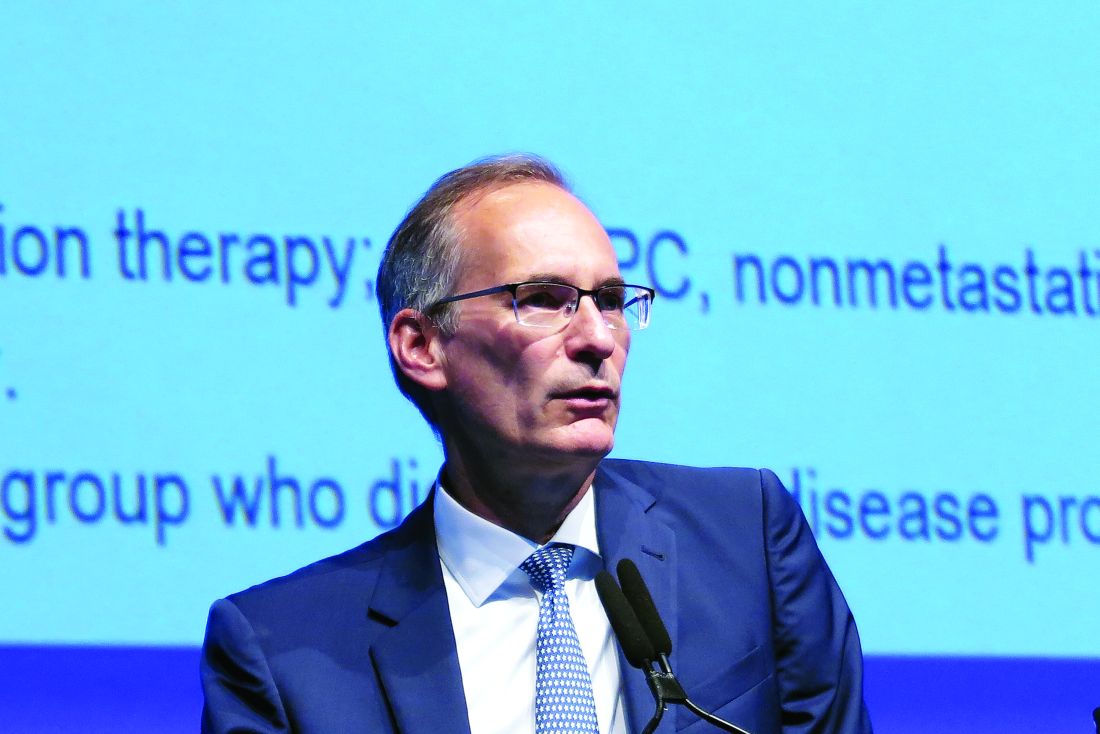User login
BARCELONA – The androgen receptor inhibitor apalutamide was associated with a 45% improvement in time to second progression in patients with nonmetastatic, castration-resistant prostate cancer as well as an overall survival edge, although the latter fell just short of statistical significance in an interim analysis of results from the SPARTAN trial.
Among 1,207 men with nonmetastatic castration-resistant prostate cancer (CRPC), those randomly assigned to apalutamide had significantly longer second progression-free survival (PFS2), an exploratory endpoint defined as the time of study entry to progression on subsequent treatment.
In all, 69% of patients on placebo and 40% of those on apalutamide went on to another life-prolonging therapy, usually abiraterone acetate (Zytiga) plus prednisone. The respective median PFS2s were 43.8 and 55.6 months, translating into a hazard ratio for second progression in the apalutamide group of 0.55 (P less than .0001).
Overall survival (OS) also trended toward a benefit for apalutamide, but the difference did not reach the prespecified boundary for significance in this planned interim analysis, reported Matthew R. Smith, MD, PhD, from the Massachusetts General Hospital Cancer Center in Boston.
Among men randomly assigned in the phase 3 trial to receive apalutamide (Erleada), the 4-year OS rate was 72.1%, compared with 64.7% for patients assigned to placebo.
“This OS benefit for apalutamide was observed despite crossover of placebo patients to apalutamide, and higher rates of subsequent life-prolonging therapy in the placebo group,” he said at the European Society for Medical Oncology Congress.
Apalutamide was approved by the Food and Drug Administration in 2018 for treatment of patients with nonmetastatic CRPC who were on androgen deprivation therapy with a rapidly rising prostate-specific antigen level and no detectable distant metastases on conventional imaging.
That approval was based on the primary results from SPARTAN, which showed a median metastasis-free survival for patients taking apalutamide of 40.5 months, compared with 16.2 months for patients taking placebo.
The drug also recently received FDA approval for treatment of men with metastatic CRPC, based on results of the TITAN trial.
Overall survival
At the time of the primary analysis of SPARTAN for metastasis-free survival, the OS data were immature, with only 104 of 427 events required for the prespecified analysis.
At ESMO 2019, Dr. Smith presented results of the second interim survival analysis looking at the effects of apalutamide on OS, as well as time to chemotherapy, PFS2, and safety.
In the trial, men with nonmetastatic CRPC were randomized on a 2:1 basis to receive either apalutamide 240 mg daily (806 patients) or placebo (401) plus androgen deprivation therapy, either with gonadotropin-releasing hormone analogue therapy or with surgical castration.
At a median follow-up of 41 months, median OS was not reached in either arm. As noted before, the 4-year OS rate was higher in the apalutamide group, translating into a HR for death of 0.75. However, the P value of .0197 was higher than the prespecified O’Brien-Fleming boundary of 0.0121, which means that the study follow-up will continue per protocol, with the final analysis for overall survival planned after 427 deaths have occurred, Dr. Smith said.
The survival benefit with apalutamide either trended toward significance across all subgroups, with notable benefits in patients aged younger than 65 years, those with good performance status, prostate-specific antigen doubling time longer than 6 months, and those with locoregional disease status of N1 versus N0.
The secondary endpoint of time to chemotherapy initiation was not formally tested because OS did not reach statistical significance, but proportionally fewer patients on apalutamide had started cytotoxic chemotherapy at the time of the interim analysis (14% vs. 20% of patients on placebo). The median time to initiation of chemotherapy has not been reached in either trial arm, however.
The safety profile of the androgen receptor inhibitor was consistent with that seen in the primary PFS analysis, with any adverse event seen in 97.3% of patients versus 93.7% of patients on placebo, grade 3-4 adverse events in 53.1% versus 36.7%, any serious adverse event in 33.5% versus 24.9%, events leading to treatment discontinuation in 13.8% versus 7.3%, and fatal adverse events in 2.1 versus .5%.
“Of some note, discontinuation due to disease progression was 34% in the apalutamide group, compared to 74% in the placebo group,” Dr. Smith said.
“These results further support apalutamide as a standard-of-care option for men with high-risk, nonmetastatic CRPC,” he concluded.
PFS2 data ‘important’
Invited discussant Karim Fizazi, MD, PhD, from the Institut Gustave Roussy in Villejuif, France, acknowledged it’s too early to draw conclusions about OS, but added that the PFS2 data are important.
The 45% reduction in risk of progression “is particularly important in this trial because abiraterone was provided as a potential salvage treatment in both arms. So in other words, in that trial they were almost truly comparing early AR [androgen receptor] targeting versus deferred AR targeting, at least in some patients, and it seems that [apalutamide] is making a difference in terms of second progression,” he said.
An unanswered question about the trial, however, is how active abiraterone was post apalutamide in the experimental, because there are data suggesting minimal efficacy in sequential therapy of AR-targeted agents, he added.
The SPARTAN trial was funded by Janssen. Dr. Smith disclosed an advisory role, research funding, and travel reimbursement for Janssen and others. Dr. Fizazi disclosed consulting for Janssen and others.
SOURCE: Smith MR et al. ESMO 2019, Abstract 843O
BARCELONA – The androgen receptor inhibitor apalutamide was associated with a 45% improvement in time to second progression in patients with nonmetastatic, castration-resistant prostate cancer as well as an overall survival edge, although the latter fell just short of statistical significance in an interim analysis of results from the SPARTAN trial.
Among 1,207 men with nonmetastatic castration-resistant prostate cancer (CRPC), those randomly assigned to apalutamide had significantly longer second progression-free survival (PFS2), an exploratory endpoint defined as the time of study entry to progression on subsequent treatment.
In all, 69% of patients on placebo and 40% of those on apalutamide went on to another life-prolonging therapy, usually abiraterone acetate (Zytiga) plus prednisone. The respective median PFS2s were 43.8 and 55.6 months, translating into a hazard ratio for second progression in the apalutamide group of 0.55 (P less than .0001).
Overall survival (OS) also trended toward a benefit for apalutamide, but the difference did not reach the prespecified boundary for significance in this planned interim analysis, reported Matthew R. Smith, MD, PhD, from the Massachusetts General Hospital Cancer Center in Boston.
Among men randomly assigned in the phase 3 trial to receive apalutamide (Erleada), the 4-year OS rate was 72.1%, compared with 64.7% for patients assigned to placebo.
“This OS benefit for apalutamide was observed despite crossover of placebo patients to apalutamide, and higher rates of subsequent life-prolonging therapy in the placebo group,” he said at the European Society for Medical Oncology Congress.
Apalutamide was approved by the Food and Drug Administration in 2018 for treatment of patients with nonmetastatic CRPC who were on androgen deprivation therapy with a rapidly rising prostate-specific antigen level and no detectable distant metastases on conventional imaging.
That approval was based on the primary results from SPARTAN, which showed a median metastasis-free survival for patients taking apalutamide of 40.5 months, compared with 16.2 months for patients taking placebo.
The drug also recently received FDA approval for treatment of men with metastatic CRPC, based on results of the TITAN trial.
Overall survival
At the time of the primary analysis of SPARTAN for metastasis-free survival, the OS data were immature, with only 104 of 427 events required for the prespecified analysis.
At ESMO 2019, Dr. Smith presented results of the second interim survival analysis looking at the effects of apalutamide on OS, as well as time to chemotherapy, PFS2, and safety.
In the trial, men with nonmetastatic CRPC were randomized on a 2:1 basis to receive either apalutamide 240 mg daily (806 patients) or placebo (401) plus androgen deprivation therapy, either with gonadotropin-releasing hormone analogue therapy or with surgical castration.
At a median follow-up of 41 months, median OS was not reached in either arm. As noted before, the 4-year OS rate was higher in the apalutamide group, translating into a HR for death of 0.75. However, the P value of .0197 was higher than the prespecified O’Brien-Fleming boundary of 0.0121, which means that the study follow-up will continue per protocol, with the final analysis for overall survival planned after 427 deaths have occurred, Dr. Smith said.
The survival benefit with apalutamide either trended toward significance across all subgroups, with notable benefits in patients aged younger than 65 years, those with good performance status, prostate-specific antigen doubling time longer than 6 months, and those with locoregional disease status of N1 versus N0.
The secondary endpoint of time to chemotherapy initiation was not formally tested because OS did not reach statistical significance, but proportionally fewer patients on apalutamide had started cytotoxic chemotherapy at the time of the interim analysis (14% vs. 20% of patients on placebo). The median time to initiation of chemotherapy has not been reached in either trial arm, however.
The safety profile of the androgen receptor inhibitor was consistent with that seen in the primary PFS analysis, with any adverse event seen in 97.3% of patients versus 93.7% of patients on placebo, grade 3-4 adverse events in 53.1% versus 36.7%, any serious adverse event in 33.5% versus 24.9%, events leading to treatment discontinuation in 13.8% versus 7.3%, and fatal adverse events in 2.1 versus .5%.
“Of some note, discontinuation due to disease progression was 34% in the apalutamide group, compared to 74% in the placebo group,” Dr. Smith said.
“These results further support apalutamide as a standard-of-care option for men with high-risk, nonmetastatic CRPC,” he concluded.
PFS2 data ‘important’
Invited discussant Karim Fizazi, MD, PhD, from the Institut Gustave Roussy in Villejuif, France, acknowledged it’s too early to draw conclusions about OS, but added that the PFS2 data are important.
The 45% reduction in risk of progression “is particularly important in this trial because abiraterone was provided as a potential salvage treatment in both arms. So in other words, in that trial they were almost truly comparing early AR [androgen receptor] targeting versus deferred AR targeting, at least in some patients, and it seems that [apalutamide] is making a difference in terms of second progression,” he said.
An unanswered question about the trial, however, is how active abiraterone was post apalutamide in the experimental, because there are data suggesting minimal efficacy in sequential therapy of AR-targeted agents, he added.
The SPARTAN trial was funded by Janssen. Dr. Smith disclosed an advisory role, research funding, and travel reimbursement for Janssen and others. Dr. Fizazi disclosed consulting for Janssen and others.
SOURCE: Smith MR et al. ESMO 2019, Abstract 843O
BARCELONA – The androgen receptor inhibitor apalutamide was associated with a 45% improvement in time to second progression in patients with nonmetastatic, castration-resistant prostate cancer as well as an overall survival edge, although the latter fell just short of statistical significance in an interim analysis of results from the SPARTAN trial.
Among 1,207 men with nonmetastatic castration-resistant prostate cancer (CRPC), those randomly assigned to apalutamide had significantly longer second progression-free survival (PFS2), an exploratory endpoint defined as the time of study entry to progression on subsequent treatment.
In all, 69% of patients on placebo and 40% of those on apalutamide went on to another life-prolonging therapy, usually abiraterone acetate (Zytiga) plus prednisone. The respective median PFS2s were 43.8 and 55.6 months, translating into a hazard ratio for second progression in the apalutamide group of 0.55 (P less than .0001).
Overall survival (OS) also trended toward a benefit for apalutamide, but the difference did not reach the prespecified boundary for significance in this planned interim analysis, reported Matthew R. Smith, MD, PhD, from the Massachusetts General Hospital Cancer Center in Boston.
Among men randomly assigned in the phase 3 trial to receive apalutamide (Erleada), the 4-year OS rate was 72.1%, compared with 64.7% for patients assigned to placebo.
“This OS benefit for apalutamide was observed despite crossover of placebo patients to apalutamide, and higher rates of subsequent life-prolonging therapy in the placebo group,” he said at the European Society for Medical Oncology Congress.
Apalutamide was approved by the Food and Drug Administration in 2018 for treatment of patients with nonmetastatic CRPC who were on androgen deprivation therapy with a rapidly rising prostate-specific antigen level and no detectable distant metastases on conventional imaging.
That approval was based on the primary results from SPARTAN, which showed a median metastasis-free survival for patients taking apalutamide of 40.5 months, compared with 16.2 months for patients taking placebo.
The drug also recently received FDA approval for treatment of men with metastatic CRPC, based on results of the TITAN trial.
Overall survival
At the time of the primary analysis of SPARTAN for metastasis-free survival, the OS data were immature, with only 104 of 427 events required for the prespecified analysis.
At ESMO 2019, Dr. Smith presented results of the second interim survival analysis looking at the effects of apalutamide on OS, as well as time to chemotherapy, PFS2, and safety.
In the trial, men with nonmetastatic CRPC were randomized on a 2:1 basis to receive either apalutamide 240 mg daily (806 patients) or placebo (401) plus androgen deprivation therapy, either with gonadotropin-releasing hormone analogue therapy or with surgical castration.
At a median follow-up of 41 months, median OS was not reached in either arm. As noted before, the 4-year OS rate was higher in the apalutamide group, translating into a HR for death of 0.75. However, the P value of .0197 was higher than the prespecified O’Brien-Fleming boundary of 0.0121, which means that the study follow-up will continue per protocol, with the final analysis for overall survival planned after 427 deaths have occurred, Dr. Smith said.
The survival benefit with apalutamide either trended toward significance across all subgroups, with notable benefits in patients aged younger than 65 years, those with good performance status, prostate-specific antigen doubling time longer than 6 months, and those with locoregional disease status of N1 versus N0.
The secondary endpoint of time to chemotherapy initiation was not formally tested because OS did not reach statistical significance, but proportionally fewer patients on apalutamide had started cytotoxic chemotherapy at the time of the interim analysis (14% vs. 20% of patients on placebo). The median time to initiation of chemotherapy has not been reached in either trial arm, however.
The safety profile of the androgen receptor inhibitor was consistent with that seen in the primary PFS analysis, with any adverse event seen in 97.3% of patients versus 93.7% of patients on placebo, grade 3-4 adverse events in 53.1% versus 36.7%, any serious adverse event in 33.5% versus 24.9%, events leading to treatment discontinuation in 13.8% versus 7.3%, and fatal adverse events in 2.1 versus .5%.
“Of some note, discontinuation due to disease progression was 34% in the apalutamide group, compared to 74% in the placebo group,” Dr. Smith said.
“These results further support apalutamide as a standard-of-care option for men with high-risk, nonmetastatic CRPC,” he concluded.
PFS2 data ‘important’
Invited discussant Karim Fizazi, MD, PhD, from the Institut Gustave Roussy in Villejuif, France, acknowledged it’s too early to draw conclusions about OS, but added that the PFS2 data are important.
The 45% reduction in risk of progression “is particularly important in this trial because abiraterone was provided as a potential salvage treatment in both arms. So in other words, in that trial they were almost truly comparing early AR [androgen receptor] targeting versus deferred AR targeting, at least in some patients, and it seems that [apalutamide] is making a difference in terms of second progression,” he said.
An unanswered question about the trial, however, is how active abiraterone was post apalutamide in the experimental, because there are data suggesting minimal efficacy in sequential therapy of AR-targeted agents, he added.
The SPARTAN trial was funded by Janssen. Dr. Smith disclosed an advisory role, research funding, and travel reimbursement for Janssen and others. Dr. Fizazi disclosed consulting for Janssen and others.
SOURCE: Smith MR et al. ESMO 2019, Abstract 843O
REPORTING FROM ESMO 2019


